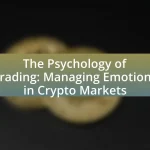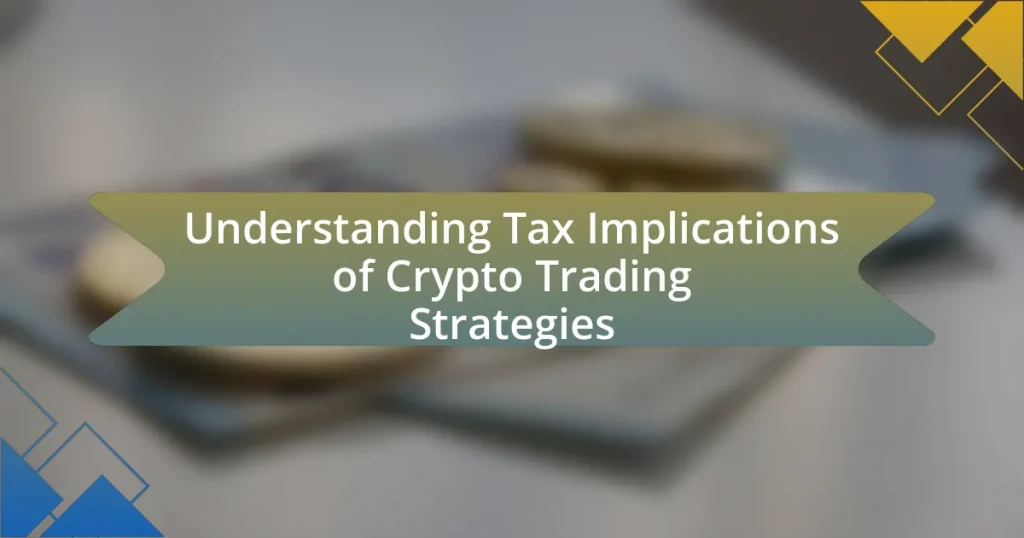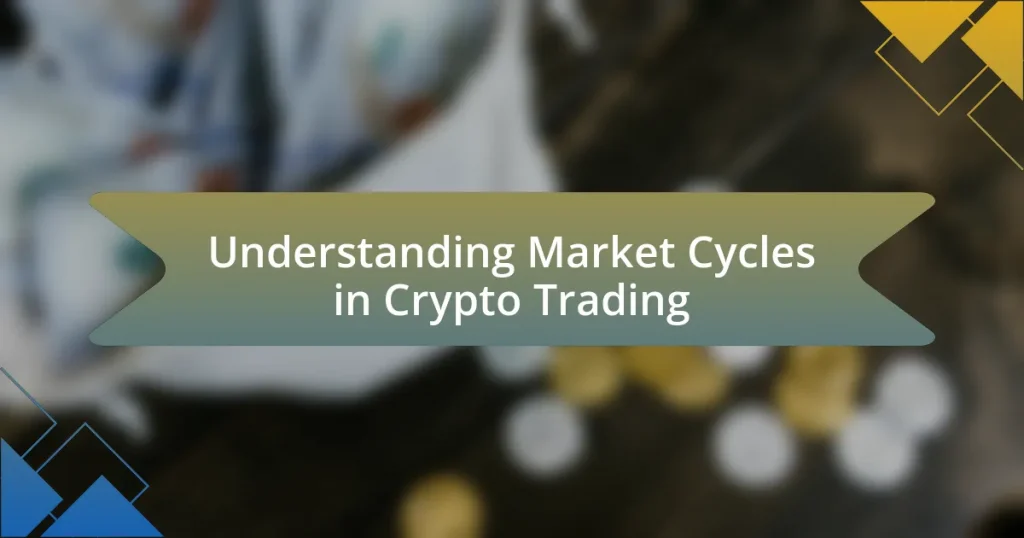Market cycles in crypto trading are defined as the recurring patterns of price movements characterized by accumulation, uptrend, distribution, and downtrend phases. This article explores how these cycles influence trading behavior, the distinct phases of market cycles, and the strategies traders can adopt during different market conditions. It emphasizes the importance of understanding market cycles for informed decision-making, risk management, and optimizing trading outcomes. Additionally, the article discusses the role of market sentiment, technical indicators, and best practices for developing resilient trading strategies in the volatile crypto market.

What are Market Cycles in Crypto Trading?
Market cycles in crypto trading refer to the recurring patterns of price movements that occur over time, characterized by phases of accumulation, uptrend, distribution, and downtrend. These cycles are influenced by market sentiment, investor behavior, and external factors such as regulatory changes or technological advancements. Historical data shows that Bitcoin, for example, has experienced multiple market cycles since its inception in 2009, with significant price increases followed by corrections, illustrating the cyclical nature of the market. Understanding these cycles helps traders develop strategies that align with market conditions, optimizing their potential for profit.
How do market cycles influence trading behavior?
Market cycles significantly influence trading behavior by dictating the sentiment and strategies employed by traders. During bullish cycles, traders often exhibit increased optimism, leading to higher buying activity and risk-taking, as evidenced by the substantial price increases observed in cryptocurrencies like Bitcoin during 2017. Conversely, in bearish cycles, traders tend to become more risk-averse, resulting in heightened selling pressure and a focus on capital preservation, as seen in the market downturns of 2018 and 2022. This cyclical behavior is supported by historical data showing that trading volumes and volatility typically rise during market expansions and contract during recessions, illustrating the direct correlation between market cycles and trading actions.
What are the different phases of market cycles?
Market cycles consist of four distinct phases: accumulation, uptrend, distribution, and downtrend. During the accumulation phase, investors buy assets at lower prices, anticipating future growth. The uptrend phase follows, characterized by rising prices and increased investor confidence. In the distribution phase, prices peak as investors begin to sell, leading to profit-taking. Finally, the downtrend phase occurs, marked by declining prices and reduced market activity, often resulting from negative sentiment. Historical data shows that these phases can significantly influence trading strategies, as traders adjust their approaches based on market conditions.
How do traders identify these phases?
Traders identify market phases through technical analysis, which involves examining price charts and indicators. They look for patterns such as higher highs and higher lows to indicate an uptrend, or lower highs and lower lows to signify a downtrend. Additionally, traders utilize tools like moving averages, Relative Strength Index (RSI), and Fibonacci retracement levels to confirm phase transitions. For instance, a moving average crossover can signal a change in trend direction, while RSI readings above 70 may indicate overbought conditions, suggesting a potential reversal. These methods are grounded in historical price behavior, allowing traders to make informed decisions based on past market cycles.
Why is understanding market cycles important for crypto traders?
Understanding market cycles is crucial for crypto traders because it enables them to make informed decisions based on the predictable patterns of price movements. Market cycles consist of phases such as accumulation, uptrend, distribution, and downtrend, which reflect the collective behavior of market participants. By recognizing these phases, traders can identify optimal entry and exit points, thereby maximizing profits and minimizing losses. Historical data shows that during bull markets, prices tend to rise significantly, while bear markets often lead to substantial declines; for instance, Bitcoin experienced a 1,400% increase from 2015 to 2017 during a bull cycle, followed by a 70% drop in 2018. This cyclical nature underscores the importance of understanding market dynamics to develop effective trading strategies.
What risks do traders face without this understanding?
Traders face significant risks without understanding market cycles, including increased potential for losses, poor decision-making, and missed opportunities. Without this knowledge, traders may enter or exit positions at inopportune times, leading to financial losses; for instance, failing to recognize a bear market can result in holding depreciating assets. Additionally, traders lacking this understanding may rely on outdated strategies that do not align with current market conditions, which can exacerbate losses. Historical data shows that traders who adapt their strategies according to market cycles tend to achieve better performance, highlighting the importance of this understanding in mitigating risks.
How can knowledge of market cycles improve trading outcomes?
Knowledge of market cycles can significantly improve trading outcomes by enabling traders to anticipate price movements and adjust their strategies accordingly. Understanding the four phases of market cycles—accumulation, uptrend, distribution, and downtrend—allows traders to identify optimal entry and exit points. For instance, during the accumulation phase, prices are generally low, presenting a buying opportunity, while the distribution phase often signals a peak, suggesting it may be time to sell. Historical data shows that traders who align their strategies with market cycles can achieve higher returns; for example, a study by the CFA Institute found that investors who timed their trades based on market cycles outperformed those who did not by an average of 3% annually. This evidence underscores the importance of market cycle knowledge in enhancing trading effectiveness.

What are the Key Trading Strategies During Different Market Cycles?
Key trading strategies during different market cycles include trend following in bull markets, where traders buy assets to capitalize on rising prices; range trading in sideways markets, where traders buy low and sell high within established price ranges; and short selling in bear markets, where traders sell assets they do not own to profit from declining prices. Historical data shows that during bull markets, such as the 2017 Bitcoin surge, trend following strategies yielded significant returns, while in bear markets like the 2018 downturn, short selling became a viable strategy for profit.
How do strategies differ between bull and bear markets?
Strategies in bull markets focus on buying and holding assets to capitalize on rising prices, while bear market strategies emphasize short selling or hedging to protect against losses. In bull markets, traders often employ momentum trading, where they buy assets that are trending upward, supported by historical data showing that during the last bull market from 2015 to 2017, Bitcoin’s price increased from around $400 to nearly $20,000. Conversely, in bear markets, traders may utilize strategies like dollar-cost averaging to gradually purchase assets at lower prices or options trading to hedge against declines, as evidenced by the 2018 bear market when Bitcoin fell from $13,880 to $3,194, prompting many traders to seek protective measures.
What specific strategies are effective in bull markets?
Effective strategies in bull markets include trend following, momentum trading, and buying the dip. Trend following involves identifying and capitalizing on upward price movements, which is supported by historical data showing that assets often continue to rise during bull markets. Momentum trading focuses on purchasing assets that have shown strong recent performance, as evidenced by studies indicating that assets with positive momentum tend to outperform in bullish conditions. Buying the dip entails purchasing assets after minor price corrections within an overall upward trend, a strategy backed by the observation that prices often recover and continue to rise after such dips in bull markets.
What strategies should traders adopt in bear markets?
Traders should adopt strategies such as short selling, hedging, and focusing on stable assets during bear markets. Short selling allows traders to profit from declining prices by borrowing assets and selling them with the intention of repurchasing at a lower price. Hedging, through options or futures contracts, can protect against further losses by offsetting potential declines in asset value. Additionally, focusing on stable assets, such as cryptocurrencies with strong fundamentals or those pegged to fiat currencies, can provide a safer investment during market downturns. Historical data shows that during the 2018 bear market, traders who utilized short selling and hedging strategies were able to mitigate losses significantly compared to those who held onto declining assets.
What role does market sentiment play in trading strategies?
Market sentiment significantly influences trading strategies by shaping traders’ perceptions and decisions based on collective emotions and attitudes towards market conditions. When sentiment is bullish, traders are more likely to buy, anticipating price increases, while bearish sentiment often leads to selling or shorting assets, expecting declines. Research indicates that market sentiment can be quantified through indicators like the Fear and Greed Index, which correlates with price movements; for instance, extreme fear often precedes market recoveries, while excessive greed can signal potential downturns. Thus, understanding market sentiment allows traders to align their strategies with prevailing emotional trends, enhancing their decision-making processes.
How can traders gauge market sentiment effectively?
Traders can gauge market sentiment effectively by analyzing various indicators such as social media trends, news sentiment analysis, and market data metrics like the Fear and Greed Index. Social media platforms like Twitter and Reddit provide real-time insights into trader emotions, while news sentiment analysis quantifies the tone of articles related to cryptocurrencies. The Fear and Greed Index, which ranges from 0 to 100, aggregates multiple factors to indicate whether the market is in a state of fear or greed, helping traders make informed decisions. For instance, a reading below 20 suggests extreme fear, often signaling a potential buying opportunity, while a reading above 80 indicates extreme greed, which may suggest a market correction is imminent.
What tools are available to analyze sentiment in crypto markets?
Tools available to analyze sentiment in crypto markets include social media analytics platforms, natural language processing (NLP) tools, and sentiment analysis APIs. Social media analytics platforms like LunarCrush and Santiment aggregate data from social media channels to gauge public sentiment towards specific cryptocurrencies. NLP tools, such as VADER and TextBlob, analyze text data from news articles and forums to determine sentiment polarity. Additionally, sentiment analysis APIs like CryptoMood and The TIE provide real-time sentiment scores based on various data sources, enabling traders to make informed decisions based on market sentiment trends.

How Can Traders Adapt Their Strategies to Changing Market Conditions?
Traders can adapt their strategies to changing market conditions by employing flexible trading plans that incorporate technical analysis, risk management, and market sentiment evaluation. For instance, during bullish market conditions, traders may focus on trend-following strategies, utilizing indicators like moving averages to identify upward momentum. Conversely, in bearish markets, they might shift to short-selling or hedging strategies to protect their capital.
Additionally, traders can analyze historical data to understand how similar market conditions affected price movements in the past, allowing them to make informed decisions. Research indicates that traders who adjust their strategies based on market cycles can improve their performance; for example, a study by the CFA Institute found that adaptive strategies can yield returns that are 20% higher than static approaches during volatile periods.
What indicators should traders monitor for market changes?
Traders should monitor indicators such as price trends, trading volume, moving averages, and market sentiment for market changes. Price trends reveal the direction of the market, while trading volume indicates the strength of a price movement. Moving averages help smooth out price data to identify trends over specific periods, and market sentiment gauges the overall attitude of investors towards a particular asset. For instance, a significant increase in trading volume alongside a price increase often signals a strong bullish trend, as evidenced by historical patterns in cryptocurrency markets.
How do technical indicators signal shifts in market cycles?
Technical indicators signal shifts in market cycles by analyzing price movements and trading volumes to identify trends and potential reversals. For instance, moving averages can indicate a change in momentum when a short-term average crosses above or below a long-term average, suggesting a shift from bullish to bearish or vice versa. Additionally, oscillators like the Relative Strength Index (RSI) can highlight overbought or oversold conditions, signaling potential market corrections. Historical data shows that these indicators have successfully predicted market shifts; for example, during the 2017 Bitcoin bull run, the RSI indicated overbought conditions before a significant price correction occurred.
What fundamental factors should traders consider?
Traders should consider economic indicators, market sentiment, and regulatory developments as fundamental factors. Economic indicators, such as GDP growth rates and unemployment figures, provide insights into the overall health of the economy, influencing asset prices. Market sentiment, often gauged through investor behavior and news trends, can drive price movements in the short term. Regulatory developments, including changes in laws or policies affecting cryptocurrencies, can significantly impact market dynamics and trader strategies. For instance, the introduction of stricter regulations in a major market can lead to decreased trading volumes and price volatility, as seen in the aftermath of regulatory announcements in 2017.
What are the common pitfalls traders face during market cycles?
Traders commonly face emotional decision-making, overtrading, and lack of a clear strategy during market cycles. Emotional decision-making often leads to impulsive trades based on fear or greed, which can result in significant losses. Overtrading occurs when traders attempt to capitalize on every market movement, leading to increased transaction costs and potential burnout. Additionally, a lack of a clear strategy can cause traders to deviate from their plans, especially during volatile periods, resulting in missed opportunities or poor execution. Historical data shows that many traders fail to adapt their strategies to changing market conditions, which can exacerbate these pitfalls.
How can emotional trading impact decision-making?
Emotional trading can significantly distort decision-making by leading traders to make impulsive choices based on fear or greed rather than rational analysis. When traders experience heightened emotions, such as anxiety during market downturns or euphoria during upswings, they may deviate from their established trading strategies. Research indicates that emotional responses can trigger cognitive biases, such as loss aversion, where the fear of losing money outweighs the potential for gains, resulting in premature selling or missed opportunities. A study published in the Journal of Behavioral Finance found that traders who allowed emotions to guide their decisions often underperformed compared to those who adhered to systematic trading strategies, highlighting the detrimental effects of emotional trading on overall performance.
What strategies can mitigate these pitfalls?
To mitigate the pitfalls associated with market cycles in crypto trading, traders can implement a diversified investment strategy. Diversification reduces risk by spreading investments across various assets, which can help buffer against the volatility inherent in crypto markets. Research indicates that a well-diversified portfolio can lower the overall risk without significantly sacrificing returns, as evidenced by studies showing that portfolios with a mix of asset classes tend to perform better during market downturns. Additionally, employing technical analysis tools, such as moving averages and relative strength indicators, can help traders identify market trends and make informed decisions, thereby reducing the likelihood of losses during unfavorable market conditions.
What are the best practices for developing a resilient trading strategy?
The best practices for developing a resilient trading strategy include diversifying investments, implementing risk management techniques, and continuously analyzing market conditions. Diversification reduces the impact of poor performance in any single asset by spreading investments across various cryptocurrencies and asset classes. Risk management techniques, such as setting stop-loss orders and position sizing, help protect capital during volatile market conditions. Continuous analysis of market conditions, including understanding market cycles and trends, enables traders to adapt their strategies effectively. Historical data shows that traders who employ these practices tend to achieve better long-term performance, as evidenced by studies indicating that diversified portfolios can reduce risk while maintaining returns.
How can traders create a flexible trading plan?
Traders can create a flexible trading plan by incorporating adaptable strategies that respond to changing market conditions. This involves regularly reviewing and adjusting trading goals, risk management techniques, and entry and exit strategies based on market cycles. For instance, during bullish phases, traders might increase their position sizes, while in bearish phases, they may focus on capital preservation and smaller trades. Historical data shows that traders who adjust their plans according to market trends can improve their performance, as evidenced by studies indicating that adaptive strategies yield higher returns in volatile markets.
What role does continuous learning play in adapting strategies?
Continuous learning is essential for adapting strategies in the context of crypto trading, as it enables traders to stay informed about market trends, technological advancements, and regulatory changes. By continuously updating their knowledge, traders can refine their strategies to respond effectively to the dynamic nature of market cycles. For instance, research indicates that traders who engage in ongoing education are better equipped to identify emerging patterns and adjust their approaches accordingly, leading to improved decision-making and risk management. This adaptability is crucial in the volatile crypto market, where conditions can shift rapidly, underscoring the importance of continuous learning in maintaining a competitive edge.















